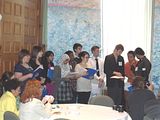Have you go an emergency kit? I didn't so let me share with you all the interesting things I have learned and now done.
This week I have been gathering together items that we might need in an emergency, called an Emergency Preparedness Kit. So what could happen here? As our home relies on electricity, if there is a serious power outage, or an ice storm, it takes a while sometimes a week or more, before life gets back to normal. Ontario has also had a cyclone some years ago, which caused major flooding. So we are working on both aspects.
Here are some good ideas.
Emergency Kit Ideas
Print this page - it is a checklist.
Emergency Supplies Checklist
There are basic supplies that you should have at home, work and in your vehicle. These supplies should be collected ahead of time and be easily accessible in the case of an emergency or disaster. Every family member should know where these supplies are located and what is in the kits.
Kits can be purchased from emergency supply companies and then personalized to suit your needs.
You can also put your own kits together by using the following Emergency Supply Checklist as a guide. Remember to check your supplies at least every 6 months and rotate perishables as required. Every member in your family including your pet(s) need emergency supplies.
Emergency Supplies Checklist
The following is a list of basic items that should be contained in your Emergency Supply Kit for your home. The kit should be stored in plastic tubs or plastic garbage cans on wheels and be located in a safe easily accessible area. All supplies in your kit might not be needed if you have to evacuate your home. What you take will depend on the situation.
Water
At least four litres of water per person per day is required (two litres for drinking and the remaining two for food preparation, hygiene and dish washing). Used plastic milk containers, even if washed, are not sterile and should not be used for storing water. Water should be stored in clean sterilized containers in your Emergency Supply Kit and replaced with fresh water every six months. Alternatively, water can also be stored in clear sterilized containers and kept in the freezer and rotated less often than every six months.
Food
When assembling the food items for your kit choose foods that:
You are familiar with
Do not require refrigeration
Need little or no preparation
Will not increase thirst
Require little or no water to prepare
Meet the needs of the individuals using the kits (babies, children, elderly, special diets, food allergies, etc.)
A manual can opener should be included with the food items in your kit.
Canned food, juices, dried fruit and dehydrated food are good choices.
Other items to consider including in your Emergency Supply Kit are: milk, high energy foods like peanut butter, jelly, low sodium crackers, granola bars, and trail mix, vitamins, cookies, hard candy, instant coffee, cereals, and powered milk.
All canned food and dry goods in your kit should be replaced once a year. Emergency Food Rations and Emergency Purified Drinking Water with a shelf life of 5 years can also be purchased through emergency supplies companies.
Equipment: Kitchen items
knives, forks, spoons
disposable cups and plates and bowls
manual can opener, bottle opener
all purpose knives
household liquid bleach (to treat drinking water) click here for instructions
waterproof matches
plastic garbage bags
sugar, salt, pepper
aluminium foil and plastic wrap
resealable plastic bags or small containers
small fuel stove and a can of cooking fuel for food that requires cooking (follow manufacturer's instructions for stove and fuel). Barbeques and propane stoves are good alternate cooking sources but are never to be used indoors. Remember to store fuel safely.
Emergency First Aid Kit
Purchase a well stocked ready made Emergency First Aid Kit. These kits are available through various sources and extra items can be added to fit specific needs. Some of the tailored items you might want to include in your kit are:
Prescription medication. Ensure all drugs are stored to meet instructions on the label and recommendations from your pharmacist. If possible, purchase an extra weeks supply of medication for your Emergency First Aid Kit and rotate the supply whenever you refill your prescription.
Extra eyeglasses and/or contact lens and cleaners. When purchasing a new pair of glasses consider placing the old pair in your Emergency First Aid Kit.
For more information on putting together your own first aid kit, visit the Provincial Emergency Program web site at http://www.pep.bc.ca/ for ideas.
Tools, Emergency Supplies and Other items
hand cranked, solar powered or battery operated radio with extra batteries
hand cranked, solar powered or battery operated flash lights with extra batteries
Light sticks (can be used as a source of light, or for signalling purposes)
waterproof matches or matches in a waterproof container
gas shut-off wrench, pliers, shovel and other tools
duct tape
scissors or all purpose knife
plastic sheeting
whistle
small canister, ABC type Fire Extinguisher
tube tent or extra large orange garbage bags
maps of the area, compass
work gloves, dust masks
paper, pens and pencils
needles and thread
Sanitation and Hygiene Items
washcloth and towel
towelettes, soap, hand sanitizer, and liquid detergent
toothpaste, toothbrush(s), shampoo, deodorant, comb and brush, razor, shaving cream, lip balm, sunscreen, insect repellent, mirror, toilet paper, feminine products, baby and/or special needs items as required
heavy duty plastic garbage bags and ties for personal sanitation uses
medium sized plastic bucket with tight lid to use as a make shift toilet (consider using a small shovel for digging a latrine if the need arises)
disinfectant and household chlorine bleach
Clothes and Bedding
a complete change of clothes for each household member, extra socks, underwear, extra diapers and baby products if necessary
rain gear, hat and gloves
sturdy footwear for each household member
sunglasses
sleeping bags, blankets, or thermal blankets
Speciality items (for the needs of infants, children, elderly, disabled persons and pets)
baby formula, food, teething gels, powders and diaper rash creams
entertainment and comfort items for children
books
medication, dentures and cleaning supplies, hearing aid and batteries
pet food, water, dish, medication and toys
Emergency Survival Kit "Grab and Go Bag" (could also be used for work or vehicle)
back pack (used as storage container for supplies)
a list of all contents of kit
first aid kit and instruction booklet (taking an accredited course is recommended)
water: bottled water or 5 year shelf life type emergency packaged water and possibly some juice boxes
food: energy bars, granola, fruit leather bars or 5 year shelf life type emergency food bars,
hand cranked, solar powered or battery operated radio with extra batteries
hand cranked, solar powered or battery operated flash lights with extra batteries
rain gear, emergency ("space") silver blankets or large orange garbage bags
work gloves and dust masks
spare set of clothes including sturdy footwear
matches and candles
swiss Army type knife
light sticks (minimum 2)
whistle
duct tape
rope
identification (including information regarding medical needs or medication)
important phone numbers such as number for your Out of Province/Area Contact Person
spare glasses (as needed)
prescription and non prescription medications (i.e., asprin)
map and compass
pen and pencil
special items for baby etc.
personal hygiene items (toothbrush and paste, waterless hand sanitizer, shampoo, deodorant, toilet paper/Kleenex, cards, games, books, etc.)
Work Place Kit (personalized to meet individual needs)
water and food
a few personal hygiene items
small flashlight and batteries
comfortable flat shoes
prescription and non prescription medications (i.e. asprin)
Personal Emergency Preparedness Checklist for People with Disabilities
Complete the following Activities
Establish a personal support network.
Customize an emergency health information card. Keep copies in wallet, purse and emergency supply kits.
Complete an emergency contact list.
Collect important documents. Store them in emergency supply kits, wallet and safe deposit box and give copies to personal support network and out of area contact.
Conduct an ability self-assessment.
Collect Grab and Go supplies to keep with you at all times. Include disability –related supplies in the kits.
Maintain a seven day supply of essential medications.
Keep important equipment and assistive devices in consistent, convenient and secured place.
Keep a whistle and a flashlight near you as this will help others find you in an emergency situation. The international signal for help is 3 short blasts
Write out instructions for items you will need help with in an emergency.
If you use a service animal be aware that your animal might not react as he/she usually does if there is a large disaster such as an earthquake.
First Aid Kit
Hat
Sun Screen


